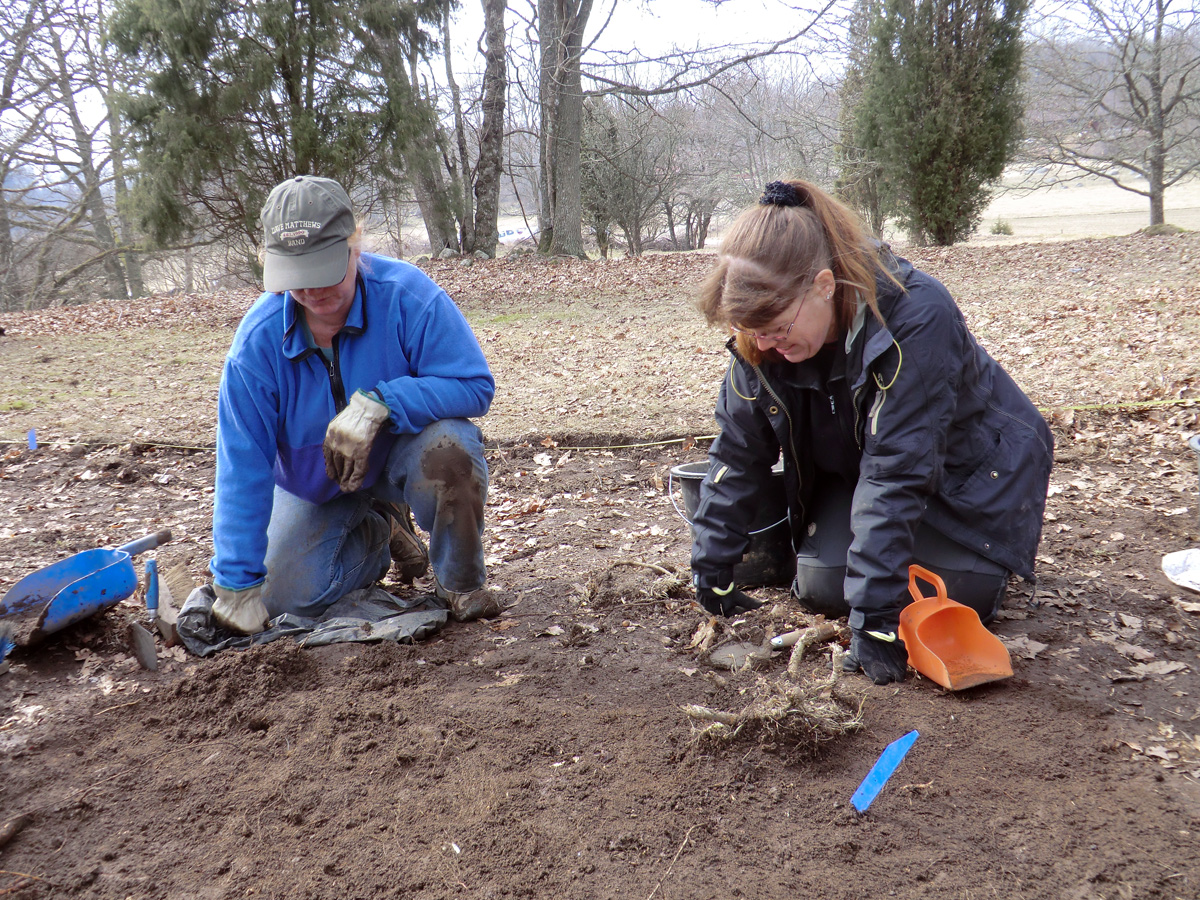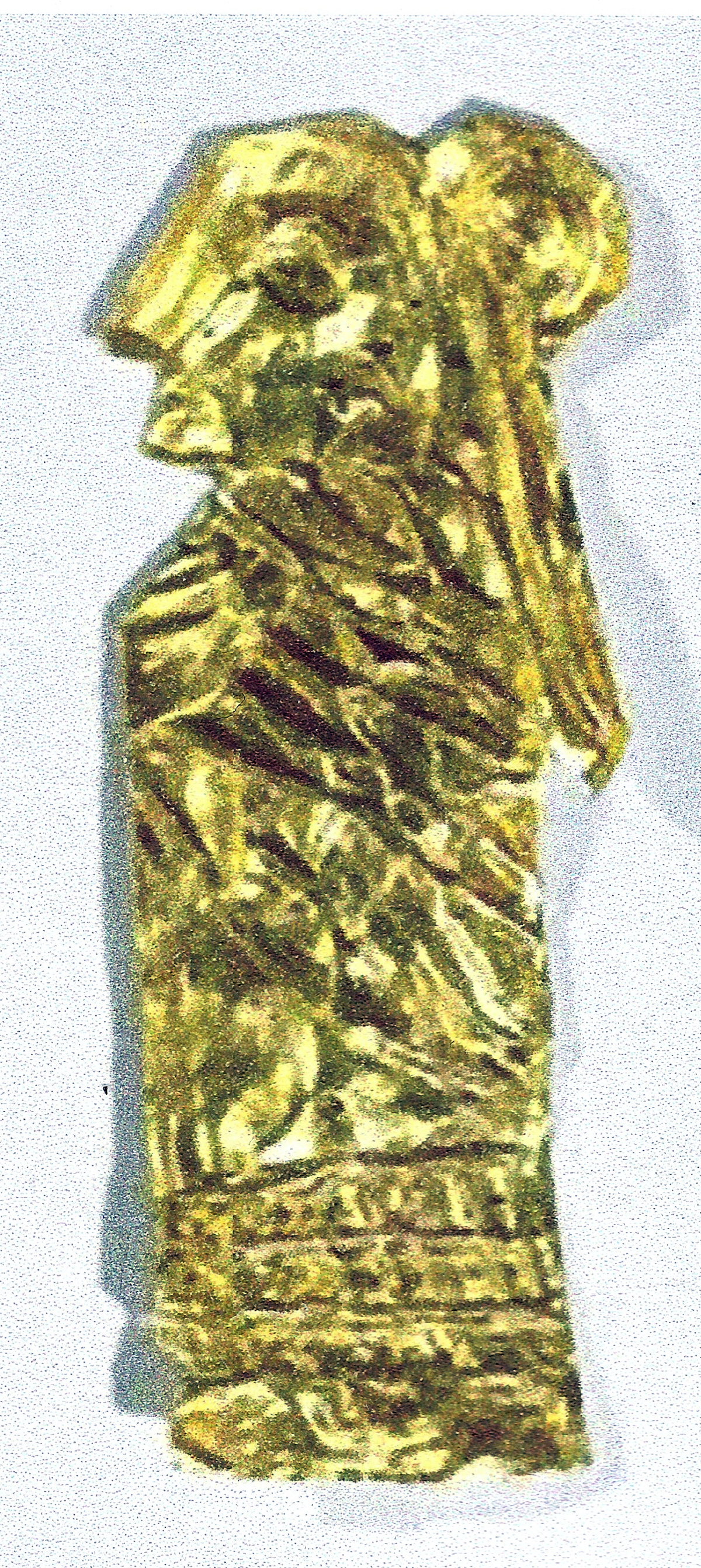 Archaeologist Maria Cunningham, right, at work at the Vasta Vang excavation. Courtesy photo
Archaeologist Maria Cunningham, right, at work at the Vasta Vang excavation. Courtesy photo Gold-foil figure of a woman dating to the Iron Age found at the Vastra Vang site. Courtesy photo
Gold-foil figure of a woman dating to the Iron Age found at the Vastra Vang site. Courtesy photo
Maria “Mia” Cunningham, a Los Alamos archaeologist, has worked in New Mexico for many years at sites ranging from downtown Santa Fe to the Valles Caldera and the desert near Las Cruces – but she is of Swedish descent, and she has always been fascinated by Swedish archaeology.
Several years ago, Mia (wife of Robert Cunningham and daughter-in-law of Paul Cunningham, both members of the Kiwanis Club of Los Alamos) started taking distance courses in archaeology from a Swedish university in her spare time.
Last spring, when she and her husband were on vacation in southern Scandinavia, she seized the opportunity to work on the excavation at Vastra Vang, an Iron-Age site in the province of Blekinge in the southern part of Sweden – a cold, damp, very rocky site totally different from the hot, dry, sandy country in New Mexico.
Feb. 4, she shared her experiences with Kiwanis. She began with a little background on Sweden’s prehistory.
“The Bronze Age period in Sweden dates roughly from 1,500 to 500 B.C., and during this time period, impressive burial mounds or cairns were built all over Sweden for high-status individuals, mainly chieftains and their famiies,” Cunninghams said.
She shared a slide of a Bronze Age burial cairn within a mile of the Vastra Vang excavation site. This burial dates from a time when prehistoric people were beginning to live communally in “substantial house structures.” They cultivated crops, domesticated animals, and learned how to cast bronze into useful tools and high-status objects.
The Iron Age in Sweden began in about 500 B.C. and ended with the dawn of the Viking Age, about 800 A.D. During the Iron Age, people learned how to cast iron to create more effective tools and weapons. The first villages in Sweden appeared, and the people built many stone fences. Her photos showed a variety of Iron-Age grave forms, all near Vastra Vang, including one that features large rocks arranged in a two-dimensional representation of the deck of a ship.
The Romans established trade routes in southern Scandinavia during the Iron Age, and new skills and exotic materials began to influence Sweden. She said, “Craftspeople fashioned objects in gold, silver, and bronze for everyday use, status symbols, and sacred objects used for religious purposes.”
A rune stone in Blekinge, called the “Bjorketorps Stone,” is also within a few miles of Vastra Vang. It carries a warning for intruders: “He who destroys this monument shall surely be plagued by angriness. Treacherous death shall be his.”
Vastra Vang itself stands on top of a hill in a small farming community. The finds there have now made it an important site—and she shared photos and information about both the work there and some of the finds. Here’s a partial list of the points she made:
- Within view of Vastra Vang, a Viking-Age silver hoard was discovered.
- The excavations that took place at Vastra Vang in April 2013 were unusual because the general public was allowed to participate, and local archaeology students from nearby universities were involved.
- Those who dug—both professionals and amateurs—peeled back a grass-mat layer to expose soil that was studied for staining, rock alignment, or anything else unusual before the work went on. At some time in the future, all of the dirt removed from the site will be screened.
- Metal detectors were then used on the site to search for objects of archaeological value. She showed photos of a cast-bronze face mask dated to the Iron Age that was found years ago in this same general area.
- Blue tags were installed to show where searchers got “hits” from metal detectors.
- During the time period that she was working at Vastra Vang, a number of exciting discoveries were made at the site. On one day, Cunningham said, “…We all gathered around a metal object poking up out of the soil. The little bronze object was face-down in the soil, and when we picked it up and turned it around, a very Roman-looking face stared back at us. This face is very stylized and is similar to another face mask that was found some years ago at the site. Other bronze objects were found, including a cast bronze ‘ring’ resembling a bracelet. It might have been part of a handle of a bronze cauldron used during religious ceremonies at the site.”
- More three-dimensional cast bronze heads were also recovered from the site. She showed photos of the heads both during excavation and months later, after they had been cleaned and restored.
- And last, but not least, 29 thin, gold-foil figures dating to the Iron Age (“guldgubbar” or, in English, “goldmen”) were found at Vastra Vang, which might have been the site of a religious temple used 2,000 years ago. The figures were 10 to 20 mm long and seemed to represent men, women, animals, and, sometimes “loving couples.”
“It is always exciting when gold is discovered at an archaeological site,” Cunningham said. “There were lots of headlines in newspapers all across Sweden when these archaeological discoveries were made public. You can see now why the use of metal detection at this site was so important.”
“In May 2014, all of the artifacts from last year’s excavations and previous discoveries in the area will be on display at the Blekinge Museum in Karskrona, Sweden,” Cunningham said. “All of the gold-foil figures, bronze heads, and glass fragments are being restored by conservators in Kalmar.”
Cunningham hopes that in the future, she herself will have the privilege of participating in fieldwork at the site and in related research.
Visit http://sciencenordic.com/treasure-trove-reveals-iron-age-town to learn more and see photos.

